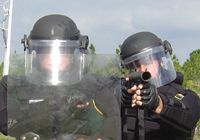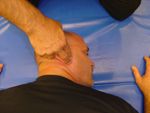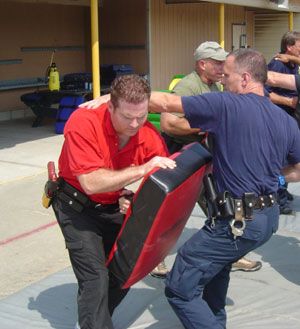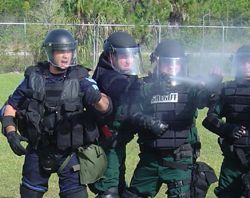Dave Young is a nationally know police, correctional, military, and tactical team trainer. Listed below are some of the safety issues that he has identified that can be addressed with training. The bottom line is that violent inmate behavior needs to be planned for, trained for, and responded to quickly and effectively to maximize safety for both staff members and inmates while sheltering the institution and individual staff members from liability.
Many of the same problems persist in corrections facilities everywhere: Overcrowding of inmates, not enough equipment for your staff or not enough training time set aside to prepare officers for the common obstacles they face. Here, I present five areas of training that are key to officer safety and survival.
Force Cell Move Strategies
Having a plan and being consistent is very important. However, when inside a correctional facility, this can also be dangerous since the actions of the officer are closely watched by the inmates. (It is often said that we are their inmates.) With this in mind, here are a few suggestions and tips for being prepared and unpredicable:
- Have more than 3 ways of conducting a force cell move on a inmate (Watch Correctional Cell Entry Tactics)
- Change the tactics so you do a different option instead of the same one right after another. This will keep the inmates on their toes — keep them guessing.

- Alternate the use of non-lethal weapons
- Using Chemical Aerosols like the MK4 or MK9 one time (also read Chemical aerosol projectile training tips)
- Then, use a Cell Buster
- Try using power as a mean of deployment in place of liquid – remember power displaces oxygen faster then liquid
- Each time you open the door keep them guessing
- Deploy the shock shield or Electrical Devices on an occasion
- There is no reason why correctional facilities do not explore all of their force options to keep the inmates on their toes. Even the presences of K9s can help modify inmates’ behavior
Take away: All officers — not just a few select ones — need to train in force cell tactics and strategies. Many times an untrained officer is thrown “in the stick,” so to speak, and asked to perform a function that he has little to no training or experience in.
Ground Stabilization Training
Securing an inmate on the ground either alone or with multiple officers can be difficult and confusing at times. Teaching your officers who to control the various limbs in the restrictive areas they work in will
 |
save time and even lives. For example:
- Head
Where the head goes the body follows. Stabilizing the head during a confrontation of a combative inmate means this will help limit the movement of the entire body. We suggest applying pressure at the “R” Axis of the jaw, turning the head to the side allows for 3 important factors:- Opens the airway
- Check for signs of responsiveness
- Check for any physical obstructions in their mouth

- Arms
Old rule of thumb was to apply an arm bar extending the arm to the side and using leverage. At times this might be impossible due to the area you are working in. We recommend using a wrist lock, by applying inwards pressure to the subjects elbow with one hand and inwards pressure to the back of the subject wrist from the other. Remember person initially moves two ways when feeling pain: One is away from it and then the other is gradually towards it if the body has overloaded the pain threshold. Also, having the arm secured to the rear in a wrist lock is also a mental compliance because the arm is behind them rather then still extended outwards from the body.
- Legs

If the subject is kicking and shifting legs you can do one of three options. Press on the extended leg heels with their toes outwards locking the leg out in place, secondly sweep one leg over the other sitting on the second leg between your calf and thigh, or third folding the legs by crossing them and securing the legs with the legs bent and crossed at the ankle grabbing the subjects belt line.
Take away: Ground stabilization is one of the most important skills an officer should know. There are many ways to get an inmate on the ground, using verbal commands, a display of force, deploying a weapon or even just taking him down to the ground. If officers have trouble stabilizing the combative actions of an inmate, this only makes it more dangerous for all parties involved.
Tactical Combinations
This is striking tactics. Using transitions between non lethal weapons and empty hands, elbows, kicks in certain combinations with each other. Learning what works well for your body type and size, and confidence level. For example:
 |
-
- Right hand straight punch, followed by cross-side elbow and cross-side knee strike
- Front kick, followed by 2 jabs from opposite hands
- Straight punch, followed by same hand backhand and knee strike
- Spraying OC, front kick, then grabbing subject to take to the ground
- Deploying an Electrical Device, followed by a front kick to the lower abdominal, then a dry stun or OC spray (Make sure your chemical aerosol projectiles are compatible with your electronic control deceives and do not start fires
- Baton strikes followed by palm check, and then knee strike or grabbing and taking subject to the ground
- Using empty hands and then having to follow it up with weapons of opportunity.
Take-away: Tactical combinations are vital. Since most physical encounters can last an indefinite period of time, an officer should know various tactical combinations to use. It’s important to remember that what works good for one officer might not be what works the best for others.
Using Hard and Soft Shields
 |
This is using the shields for deflecting, blocking, defending. Being both offensive and defensive with them. Each one is designed for specific use. For example:
- Hard shields come in a variety of sizes
- Designed to block objects or pin subjects
- Provides a hard barricade between officers and subject
- Allows the officers the ability to see through the shield
- Soft Shields are designed for maximum blunt trauma protection or pin subjects
- Designed to take the most blunt force trauma then hard shields
- Gives the officers a soft barricade to protect officers and inmate
- Can bend into smaller areas to help pin inmate
- Training with shields should cover:
- Blocking, reflecting, striking
- Redirecting force
- Retention of shield
- Trapping inmate to objects
- Weapon control and deployment
- Moving in various environments
- Officer rescue
Take-away: Using Shields incorrectly in any facility can jeopardize officers’ lives. We use shields to give us a protective barricade between us and the threat. Using shields correctly can help accomplish missions on a safer level for all officers in the tactical situation they may encounter.
 |
Non-Lethal Weapon Deployment
These non lethal weapons are a force multiplier for corrections. Enabling officers the ability to secure an area, control violent inmates, protect lives and property and engage inmates and various distances.
- Areas that should be cover should include:
- Tactical Deployment in various troubled areas inside your facility
- Reinforcing the ground stabilization plan for the non lethal weapons when they work
- Addressing the tactical response plan for the non lethal weapons do not work as expected
- Communications needed between officers and other staff
- Officers survival if held as a hostage
- What to do if these non lethal weapons are taken from the officer and used on them
Take-away: Non-lethal weapons are exactly that: not lethal. However, they are capable of causing serious bodily harm which may result in death if used incorrectly —even to the officer deploying them. Having a control plan, escalating options, transitions skills and knowing the limitations of your non lethal weapons are critical for any mission’s success.












